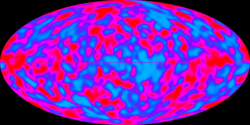Cosmic Background Explorer
| Cosmic Background Explorer | |
 | |
| Allmän information | |
|---|---|
| Status | Inaktiv |
| Organisation | NASA |
| Större entreprenör | GSFC |
| Andra namn | Explorer 66 |
| NSSDC ID | 1989-089A[1] |
| Uppdragets varaktighet | 4 år, 1 månad, 5 dagar |
| Uppskjutning | |
| Uppskjutningsplats | Vandenberg SLC-2W |
| Uppskjutning | 18 november 1989, 14:34:00 UTC |
| Uppskjutningsfarkost | Delta |
| Omloppsbana | |
| Typ av omloppsbana | SSO |
| Omloppstid | 102,5 min |
| Apogeum | 891,4 km |
| Perigeum | 877,8 km |
| Grader | 99° |
| Rymdteleskopets egenskaper | |
| Diameter | 19 cm |
| Våglängd | Mikrovågor & Infraröd |
Cosmic Background Explorer (COBE) eller Explorer 66 är en kosmologisk satellit som sändes upp av NASA 1989. Den var konstruerad för att göra mätningar på den kosmiska bakgrundsstrålningen. Mätningarna som gjordes visade dels att bakgrundsstrålningen var i stort sett isotrop, dvs lika åt vilket håll man än mäter, och dels att strålningens frekvensfördelning svarade mot en svartkroppstrålare. Dessa resultat är båda sådana som hade förutsagts utifrån Big Bang-teorin och ses därför som starka argument för denna teori.
Instrument
De tre instrumenten på COBE överlappade delvis varandras våglängdsområden. Resultaten från mätningarna har haft stor betydelse för vårt sätt att se på universums utveckling.
| Instrument | Förkortning | Beskrivning | Huvudansvarig |
|---|---|---|---|
| Differential Microwave Radiometer | DMR | ett mikrovågsinstrument för att mäta den kosmiska bakgrundsstrålningen CBM | George F. Smoot |
| Far-Infrared Absolute Spectrometer | FIRAS | En spektrometer för att mäta CBM-spektrum | John C. Mather |
| Diffuse Infrared Background Experiment | DIRBE | En infraröd-detektor | Mike Hauser |

Mätning av små avvikelser i bakgrundssrålningen
Med hjälp av DMR gjordes mätningar under en fyraårsperiod. Man kunde med hjälp av dessa data skapa en komplett karta över universums bakgrundsstrålning med dess små variationer. Variationerna är i storleksordningen 100μK vilket endast är en hundratusendel av bakgrundsstrålningens värde. Dessa små variationer tyder på att universum inte var helt homogent under den tid efter Big Bang då universum svalnat så mycket att atomer kunde bildas.
Bakgrundsstrålningens svartkroppskurva

Mätningarna av frekvensfördelningen med hjälp av COBE`s spektrometer FIRAS visade att denna strålning precis har spektrum som en svartkroppsstrålare med temperaturen 2,725 Kelvin.
Källor
- NASA’s COBE-sait (engl.)
- The Irony of NASA’s Nobel. New York Times, 5 oktober 2006.
- Nobelstiftelsens officiella hemsida
- Populärvetenskaplig information om nobelpriset i fysik 2006 från KVA, på svenska
- ^ ”NASA Space Science Data Coordinated Archive” (på engelska). NASA. https://nssdc.gsfc.nasa.gov/nmc/spacecraft/display.action?id=1989-089A. Läst 29 mars 2020.
Externa länkar
 Wikimedia Commons har media som rör COBE.
Wikimedia Commons har media som rör COBE.
| ||||||||||
| ||||||||||||||||||||||
Media som används på denna webbplats
The monopole spectrum of the Cosmic Microwave Background Radiation using the original data set by the FIRAS team, available at http://lambda.gsfc.nasa.gov/product/cobe/firas_monopole_get.cfm. The vertical axis "MJy/sr" corresponds to 106 jansky per steradian, where a jansky is 10-26 Watts per square-meter per Hertz. The horizontal axis ("1/cm") corresponds to the reciprocal of the microwave wavelength (in cm), which is proportional to the microwave frequency. The error bars are too small to be displayed by a computer screen, but vastly exaggerated error bars were included to show the measured data points. Made with GNUPlot.
NASA's comment on the original picture: "Cosmic Microwave Background (CMB) spectrum plotted in waves per centimeter vs. intensity. The solid curve shows the expected intensity from a single temperature blackbody spectrum, as predicted by the hot Big Bang theory. A blackbody is a hypothetical body that absorbs all electromagnetic radiation falling on it and reflects none whatsoever. The FIRAS data were taken at 34 positions equally spaced along this curve. The FIRAS data match the curve so exactly, with error uncertainties less than the width of the blackbody curve, that it is impossible to distinguish the data from the theoretical curve. These precise CMB measurements show that 99.97% of the radiant energy of the Universe was released within the first year after the Big Bang itself. All theories that attempt to explain the origin of large scale structure seen in the Universe today must now conform to the constraints imposed by these measurements. The results show that the radiation matches the predictions of the hot Big Bang theory to an extraordinary degree. See Mather et al. 1994, Astrophysical Journal, 420, 439, "Measurement of the Cosmic Microwave Background Spectrum by the COBE FIRAS Instrument,"Wright et al. 1994, Astrophysical Journal, 420, 450,"Interpretation of the COBE FIRAS CMBR Spectrum," and Fixsen et al. 1996, Astrophysical Journal, 473, 576,"The Cosmic Microwave Background Spectrum from the Full COBE FIRAS Data Sets" for details."
Explorer 1 satellite
Temperature of the Cosmic Microwave Background (CMB) radiation spectrum as determined with the COBE satellite during the first two years of the Differential Microwave Radiometer (DMR) observation. The plane of the Milky Way Galaxy is horizontal across the middle of each picture.
In this map, the dipole due to the solar system movement has been removed, as well as the radiation of our own galaxy.
Note: This map is based on data collected over the two first years of the four-year COBE mission. Therefore, it has been superseded by the four-year map.






